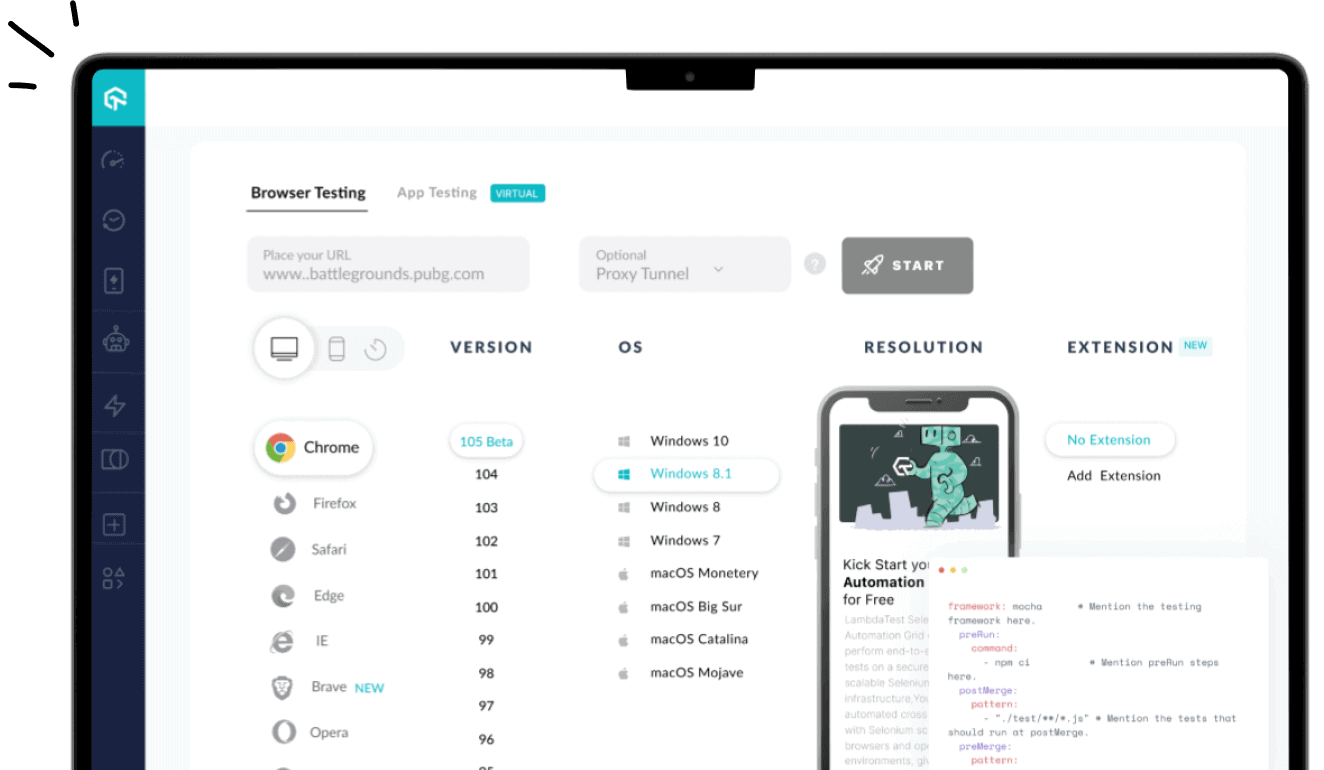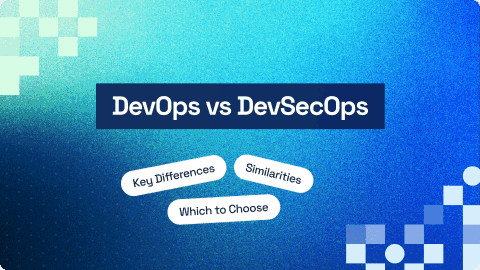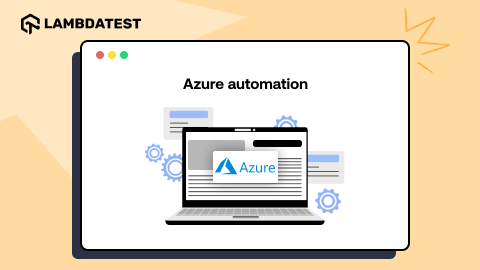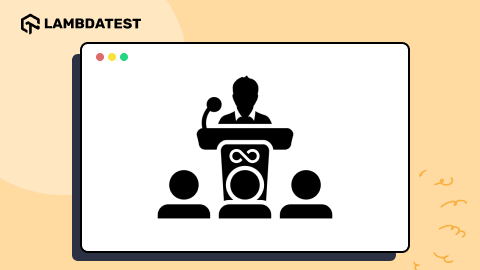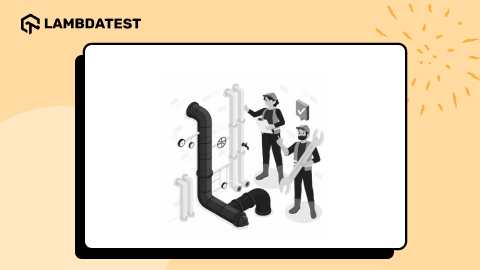CircleCI vs Jenkins: Choosing The Right CI CD Tool
Praveen Mishra
Posted On: July 8, 2020
28 Min
In the fast-paced software industry, Continuous Integration and Continuous Delivery (CI/CD) have become essential for achieving faster and more reliable releases. Among the many CI/CD tools available, CircleCI vs Jenkins remains one of the most common comparisons for DevOps teams.
Jenkins, a long-standing open-source CI/CD tool, offers extensive plugin support and flexibility for customized workflows. CircleCI, on the other hand, brings a modern, cloud-based approach that simplifies setup and automates builds, tests, and deployments without the need for server management.
This blog compares CircleCI vs Jenkins in terms of performance, scalability, ease of use, and ecosystem support, helping you decide which tool best fits your development and deployment needs.
Overview
What Is Continuous Integration (CI)?
Continuous Integration (CI) is the practice of frequently merging code changes into a shared repository where automated builds and tests run. It helps detect bugs early, maintain code quality, and ensure that new code integrates smoothly with existing functionality.
What Is Continuous Delivery (CD)?
Continuous Delivery (CD) extends CI by ensuring that the software is always in a deployable state. It automates the release process so updates can be delivered to staging or production environments quickly and safely with minimal manual effort.
CircleCI vs Jenkins: What’s The Difference?
Both CircleCI and Jenkins are popular CI/CD tools, but they differ in setup, scalability, and customization. CircleCI simplifies cloud-based automation, while Jenkins offers more flexibility and control through self-hosted configurations.
- Platform Type: CircleCI is a cloud-based CI/CD platform; Jenkins is a self-hosted, open-source automation server.
- Setup Effort: CircleCI offers quick, hassle-free setup; Jenkins requires manual configuration and ongoing server management.
- Scalability: CircleCI scales automatically in the cloud; Jenkins scaling depends on your infrastructure and manual resource adjustments.
- Customization: Jenkins supports extensive plugins for deep customization; CircleCI provides more limited, streamlined configuration options.
- Maintenance: CircleCI requires minimal upkeep as a managed service; Jenkins demands continuous maintenance and updates from you.
- User Experience: CircleCI provides a modern, intuitive UI; Jenkins uses a traditional interface that requires more configuration knowledge.
- Speed & Efficiency: CircleCI delivers faster build execution using cloud resources; Jenkins speed varies based on your local hardware or chosen infrastructure.
Which CI/CD tool offers better performance monitoring and insights, CircleCI or Jenkins?
CircleCI provides built-in performance insights directly within its dashboard, letting teams analyze job durations, success rates, and workflow efficiency out of the box. These metrics help quickly identify bottlenecks and inefficient jobs without extra tooling. Jenkins can achieve similar visibility but requires third-party plugins or integrations (for example, Build Monitor, Prometheus, and Grafana) and additional setup to collect, store, and visualize metrics.
Chapters
- What is Continuous Integration and Continuous Delivery
- What Is CI/CD Testing
- Building a QA Pipeline Within CI/CD
- CI/CD in Automation Testing
- Best Practices
- Challenges and Solutions
- Top CI/CD Tools
- DevOps vs CI/CD
- Jenkins vs GoCD
- Bamboo vs Jenkins
- CircleCI vs Jenkins
- CircleCI vs GitLab
- Travis CI vs CircleCI
- Jenkins vs GitLab CI
- Building Pipeline With Bamboo
- Building Pipeline With TeamCity
- Building Pipelines With Azure DevOps
- Building Pipeline With Travis CI, Docker, and LambdaTest
TABLE OF CONTENT
- What is Continuous Integration?
- What is Continuous Delivery (CD)?
- Why CI CD Has Become Inevitable In Modern SDLC?
- Continuous Integration With CircleCI
- Automating Builds With Jenkins
- CircleCI vs Jenkins: What’s The Difference?
- Integrating CI/CD Tools With Cloud-Based Test Automation Platform
- Frequently Asked Questions (FAQs)
So, What is Continuous Integration?
Continuous integration is a development approach where programmers merge their code into a shared repository, which is further verified by automated test and build sequences.
Continuous Integration simplifies integration into a quick, easy-to-repeat production process and ensures that any errors in the process are identified at an early stage. This approach leads to a significant reduction of integration issues and helps teams to release their software rapidly.
By utilizing continuous integration for your development cycle, you can even reduce your costs up to a significant amount. This owes to the faster development cycles as the integration errors reduce & are identified much earlier. You no longer need to backtrack and spend precious time finding these errors. The integration process also gets much shorter and easier. All of these factors lead to a faster go-to-market launch and giving teams more time to work on new features, eventually reducing the production cost.
Continuous integration focuses on test data and automatic system deployment to smoothen the integration process. Switching to CI can be a big transition for your developers but certain tools will help you get the work done faster. These tools can help pace up the deployment process. Here’s a list of tool to get you started:
- CircleCI: You can start using CircleCI for free. This is basically popular for GitHub projects and sports a self-hosted and a hosted solution.
- Jenkins: An open-source platform that offers you ample versatility.
- Pipelines: Launched by Microsoft this tool is free for up to 5 users.
- Gitlab CI: A GitLab tool which can also be combined with several other tools through the API. It is available free of cost from Gitlab.
Role Of Automation Testing In CI CD Pipeline
What is Continuous Delivery (CD)?
Continuous delivery is a software development process wherein the development phase is more streamlined to allow fast and efficient deliveries to production. A successful continuous delivery method requires ensuring that it can always be in a state where it can be immediately deployed. For CD, app delivery is a regular process with no sentiment of immediacy.
What’s really important about the CD is it will deploy the same resource in all settings. As a consequence, a build-in CI occurs just for once but not for every setting. The created resource should function with placeholders or data structures for a build-on design.
Again an important aspect is that, in order for the deployment to be successful, every condition other than the production has to be the same. Testing, development, and staging must be conducted in a production-friendly environment. Uniform systems can be difficult to maintain in large companies, but the aim is to utilize the same resources, procedures, and settings in all situations.
Key Points to Remember While Deploying With Continuous Delivery:
There are a few points that you need to consider while deploying with the CI/CD tools. These are:
Deploy in smaller batches:
Typically, the reliability of the program is at risk any time a release happens. As a consequence, it is preferred to separate deployments from one another. Yet the trouble with this method is that we end up making a lot of changes.
Odds are that all of the improvements might have complications, causing us to scale back the other adjustments that were going on. Therefore CD promotes that deployment should be executed in small batches to maintain the quality of the process and lower the risk of web application halt.
Delegate Responsibility:
Continuous delivery requires a motivated workforce, as the deployment pipeline is not only a DevOps issue, there should be a collaboration between the DevOps and development team. DevOps should try solutions to support developers in order to create good quality web apps. So they’re not only trying to do the same by advising, as well as by offering all the appropriate resources that a developer may use to solve the issues.
Triggered Automation:
All of the repetitive and redundant manual tasks during each deployment can be automated. It’s hard to eliminate human errors, a lot of time developers might end up making mistakes which can’t be completely in control, by automating some of these processes can result in fewer errors.
Continuous Delivery Tools
- Azure Pipelines
- Jenkins
- Gitlab CI
- GoCD
- Spinnaker
What Made CI/CD Inevitable For DevOps & Agile Methodology?
The introduction to CI / CD significantly improved the way programmers and software testers deliver applications. Starting with waterfall and agile the programming technology has now surfaced with DevOps. Different approaches to Continuous Integration, Continuous Development (CI/CD), and Continuous Deployment have emerged with the emergence of DevOps.
Existing app design and distribution approaches are progressively growing out-dated. Previously, in an agile setting, most corporations deployed and exported apps in at least a monthly based release system that easily extended up to quarterly, annual, or even biannual. But currently, with the DevOps framework, the standard is regularly, monthly, and sometimes several times per day.
This is particularly valid when SaaS takes over and from there you can quickly upgrade apps on the go without requiring clients to download additional extensions. Programming teams transitioned to shorter development times by promoting automation through their product production system. Some organizations provide automatic systems to test technology and adapt to different configurations.
Continuous integration relies on integrating the job outputs of different programmers into repositories. It is mostly performed many times per day, as well as the main priority is to allow rapid recognition of integration bugs, which will ultimately result in better cooperation and further development coordination.
The main focus of continuous delivery is to smoother the process in the launch or release phase. Implementation requires the ability to automate each phase in constructing implementations such that a stable delivery of the application can be achieved. Continuous deployment has become a greater standard of automated processes wherein builds / deployment takes place in an automated manner as significant adjustments are integrated into the application.
Continuous Integration With CircleCI
CircleCI is a cloud-based CI/CD tool that automates installation and delivery procedures. It offers quick configuration and maintenance without any complexities. Since it is a cloud-based CI/CD tool, it eliminates the redundancy of a dedicated server and cuts down the cost of maintenance of a constant local server host. Moreover, the cloud-based server plans are scalable, robust, and facilitate faster deployment of applications.
CircleCI manages about one million tasks per day in aid to 30,000 organizations. Clients tend to use CircleCI as their go-to CI/CD tool since projects are performed faster and build are well optimized. CircleCI can also be used to operate really complicated pipelines effectively with docker layer caching, advanced caching, and resource class to operate on faster computers. It further facilitates scalable performance-based pricing options. In the role of a developer, you can setup CircleCI using Secure Shells (SSH) in order to debug the issues in the build. Additionally, you can also set up parallel builds for faster execution of multiple processes.
Once the application repository on GitHub has been approved and submitted to circleci.com in form of a project, any code update executes automatic checks in a fresh container or VM. CircleCI can execute every task in a dedicated container or File. It means that every time you run your project on CircleCI it creates a new container to run the task.
Following the completion of the execution of the task, the CI/CD tool sends an email notification to the tester informing about the success or failure of the executed code. CircleCI further sports IRC notification and integrated Stack. The coverage result of the code can be easily retrieved from the reporting library available at CircleCI. CircleCI can be tailored from deploying code to diverse platforms such as:
- Kubernetes
- Microsoft Azure
- AWS CodeDeploy, AWS EC2, AWS S3
- Heroku
- And other platforms by using SSH or configuring the API client.
CircleCI works collaboratively on Devops testing of all design updates until they are deployed through a variety of approaches, such as integration tests, unit tests, and functional tests. CircleCI is compatible with Linux, OSX, containers and can operate independently without the need of additional plugins within a data centre or private cloud servers.
Key features of CircleCI
- It offers automated parallelism to speed up the deployment of multiple executions.
- Quick set-up
- Varied Customisation
- It’s straightforward and easy to get started
- Compact and quick to interpret setup of YAML
- Does not require a dedicated server to operate CircleCI.
- It caches application specifications and third-party configurations instead of system deployment.
Webinar: Running Effortless Continuous Testing Pipelines With CircleCI & LambdaTest
Automating Builds With Jenkins
Jenkins is an open source CI/CD tool and an integrated development and automated deployment framework that yields higher efficiency. Jenkins is used to continuously create web applications, making it easier for developers to incorporate improvements to the code.
Jenkins, as a CI/CD tool, was initially created as a prototype for the Hudson as automation server. The development for Hudson began early at Sun Microsystems in 2004. It was first launched on Java.net in the year 2005. In November 2010, a concern emerged throughout the Hudson group in regard to the technology utilized, which expanded to involve concerns regarding the operations and supervision of Oracle.
Jenkins is used to set up the CI/CD environment in an easy manner, for almost any language and source code repositories , it also helps in automating the whole build process.
Jenkins combines life-cycle production processes for most aspects, like static analysis, build, deploy and more. Approximately 1,000 plugins have been created by the Jenkins team, allowing the app to interact with other common technology.
With the support of extensions, Jenkins ensures continuous integration. Making it a go to CI/CD tool. Extensions require the incorporation of different stages of DevOps. When you decide to add a different application, you also have to set up the modules for that device. For example, Gradle, Amazon AWS, Git, Maven 2, etc.
This helps you to continually develop your applications while offering an effective CI/CD tool to identify the pipelines and combine them with a broad variety of monitoring and delivery technology. Jenkins itself is a continuous integration platform.
Key Jenkins features
- Jenkins interacts with around all the SCM or constructs methods that currently exist.
- Jenkins could be completely programmed from the helpful cloud Interface with robust on-the-fly bug tests and inline support.
- In Jenkins some aspects could be expanded and updated, so it’s easy to set up fresh Jenkins extensions. This function helps you to tailor Jenkins for your requirements.
- Jenkins is able to spread build / test loads to several machines of various platforms.
Continuous development also requires high-frequency revisions to refine the way programming operates; it enables real-time tests to determine how coding adjustments meet clear corporate goals.
Coders have a channel to deliver clear input to the company through Jenkins. There would represent a substantial shift in the business world.
Read – Best Jenkins Pipeline Tutorial For Beginners [Examples]
This Jenkins Tutorial for beginners and professionals will help you learn how to use Jenkins, one of the most popular CI/CD tools used in DevOps.
CircleCI vs Jenkins: What’s The Difference?
In the realm of Continuous Integration and Continuous Deployment (CI/CD) solutions, CircleCI and Jenkins stand out as two powerful contenders. Both platforms aim to streamline software development workflows, but they boast distinctive features and functionalities. This comprehensive comparison delves into the core attributes of CircleCI and Jenkins, assisting you in making an informed decision about the best fit for your development needs.
Now coming back to the main question, CircleCI vs Jenkins, which one is better and which one you should prefer. Rather than jumping to conclusions and stating who’s the winner in, CircleCI vs Jenkins. I’ll go through a few major points to define who’s better.
Build Control
In Jenkins, build is powered via the Jenkins UI, so all task configurations are maintained in the Jenkins system files mostly on Jenkins database, rendering it challenging to exchange setup information with the team or organisation. Github or such source servers cannot access the data contained in Jenkins.
In CircleCI, developers can create all tasks in a single document named “circle.yaml.” It’s simple because the CI setup would be like all other source repositories that render it easier to backup and share. Only a limited amount of settings such as confidential info can be stored in an encrypted manner.
With the simplicity and ease to use CircleCI is the clear winner for CircleCI vs Jenkins.
Server
Jenkins requires a dedicated server that needs constant maintenance by the allocated team. It further needs installation of all dependent Jenkins tools and plugins and debugging of issues.
CircleCI is a cloud based platform therefore it functions on a scalable online server. It is an independent tool where any updated code is automatically executed in a new container.
Again, CircleCI with a cloud server provides better scalability and less maintenance, making it a winner in this section of CircleCI vs Jenkins.
Debugging
In Jenkins debugging is a complex process as it needs manual DevOps testing and integrated team support.
Debugging in CircleCI is easier due to SSH and automated DevOps testing features.
With an easier debugging process, CircleCI is yet again a clear winner in this category of CircleCI vs Jenkins.
User Interface
The UI of Jenkins is comparatively slower and less responsive as it loads on a local hosted server and sports a high range of plugins to deploy.
CircleCI’s UI is constantly developing with updates that make it popular with clients. It further has independent built in support that makes it quicker and more responsive.
Everyone adores a good UI, due to this it is a no brainer that CircleCI wins this category of CircleCI vs Jenkins.
Docker Workflow
In Jenkins, developers have no built-in assistance for Docker workflow, a developer requires to install it and deliver it usable in the built-in area.
In CircleCI, developers have built-in assistance for Docker in the workflow that can be reached by inserting in the services segment of the circle.yaml script.
With built-in assistance for Docker in the workflow, CircleCI proves to be better in this category of CircleCI vs Jenkins.
Parallel Builds
Jenkins aids several tasks by multi-threading.
CircleCI provides built-in support for parallelism that can be accomplished across developer options.
This is a tie, as both offer parallel tasks in this category of CircleCI vs Jenkins.
Data Protection
Confidential files and encrypted data can be well protected in Jenkins servers by utilizing Jenkins plugins and credentials.
CircleCI offers a limited setting for encrypted files and maximum data on CircleCI is available for developers to access.
We have a clear winner, CircleCi wins the battle of CircleCI vs Jenkins, as it comes out on top as a scalable option with a better UI.
Integrating CI/CD Tools With Cloud-Based Test Automation Platform
Now that you know the answer to CircleCI vs Jenkins, let’s move ahead with how you can integrate the Selenium test automation tool with CircleCI for DevOps testing.
DevOps testing or Continuous testing is the combination of both CI/CD and test automation, where you test every build when it is either committed, integrated, pushed to a new environment and lastly on deployment.
This is why LambdaTest integration with CI/CD tools can boost your go-to-market launch. With LambdaTest Selenium grid, you can perform. By leveraging parallel testing offered by the Selenium grid, you can significantly reduce your DevOps testing cycles and time spent on executing the automation test cases.
As a prerequisite to run your automation tests, you need to ensure that node.js and the node package manager are installed in the system. To connect to the LambdaTest Selenium Grid, you’d need the access key token to connect and execute automated tests on LambdaTest. This access key is unique for every user and it can be fetched and regenerated from the individual user profile section of the user account as shown below.

Alternatively, you can also fetch the access key, username and hub details from the Automation dashboard as shown in the image screenshot below.
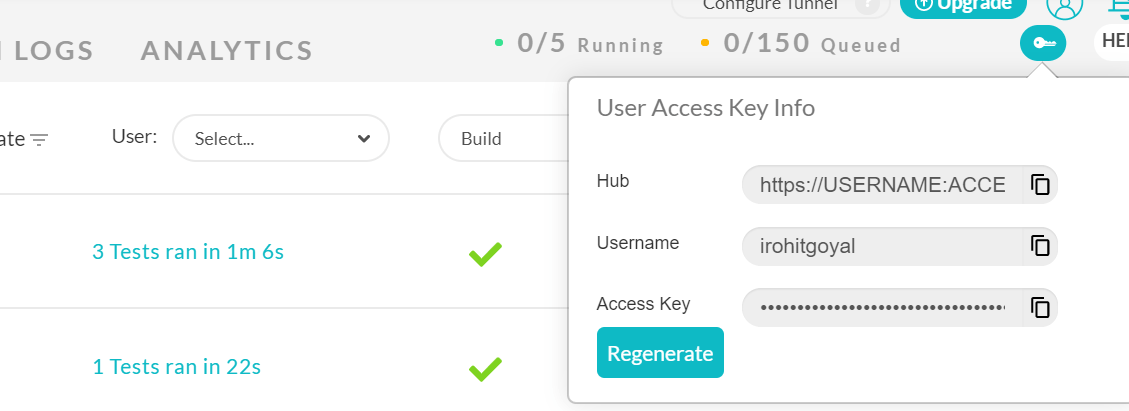
In order to integrate CircleCI with the Lambda Test, you need to make a few changes in the CircleCI configuration file i.e. cirleci/config.yaml file. The changes required will be majorly include changes in the environment details and the access key token to connect to the online platform.
For setting up the environment details LambdaTest provides the capabilities generator. Here is the link to visit LambdaTest Selenium desired capabilities generator where we can specify the desired environment, we would like to perform our test. This capability generator will generate the required configuration for us which we can use in our config file.

This is the desired capabilities that is generated for the target environment.
|
1 2 3 4 5 6 7 8 9 10 11 |
var capabilities = { "build" : "your build name", //You can edit this and assign a build name "name" : "your test name", // Assign a name to your Test "platform" : "Windows 10", // The operating system on which you want to test your website "browserName" : "Firefox", // The browser on which you want to test "version" : "71.0", // The browser version which you've selected to perform the test upon "resolution" : "1024x768", // The resolution in which you want to run the test as per your operating system "selenium_version" : "3.11.0", //The version of Selenium on which the test will run "visual" : true, "firefox.driver" : v0.21.0 } |
Finally, we have the configurations done and below is the sample file that can be used to perform the integration of CircleCI with LambdaTest. Here we are running selenium test automation with the Nightwatch framework.
The command used for executing the tests is :
|
1 |
$ node_modules\.bin\nightwatch -e firefox |
Lastly, we can use LambdaTest Automation Dashboard to monitor, analyze and track the progress of our test results.
Also Read: 16 Best Practices Of CI/CD Pipeline To Speed Test Automation
Wrapping It Up!
In conclusion, the key difference between CircleCI vs Jenkins is that Jenkins is more secure and elaborates; CircleCI is lightweight and open. Therefore for faster deployment jobs, one can execute their codes on CircleCI as it deploys on scalable and robust cloud servers. These days CircleCI is a more preferred CI/CD tool and is used widely across the technology industry. Hence, with CircleCI you can deploy code in a reliable manner and by integrating with cloud Selenium grid-like LambaTest you can perform continuous testing in a more scalable manner, also ensuring a faster go-to-market launch.
That’s all for now! I hope you found this article on CircleCI vs Jenkins informative, and now know which CI/CD tool to use. Let me know which is your favorite CI/CD tool or which one you think is better. Do share this article with your peers, this might also save some time if they are also wondering in CircleCI vs Jenkins, which one is better. That’s all for now. Happy Testing!!!?
Frequently Asked Questions (FAQs)
Which CI/CD tool offers better performance monitoring and insights, CircleCI or Jenkins?
CircleCI provides built-in performance insights directly within its dashboard, letting teams analyze job durations, success rates, and workflow efficiency out of the box. These metrics help quickly identify bottlenecks and inefficient jobs without extra tooling. Jenkins can achieve similar visibility but requires third-party plugins or integrations (for example, Build Monitor, Prometheus, and Grafana) and additional setup to collect, store, and visualize metrics.
How do CircleCI and Jenkins handle version control system (VCS) integrations?
CircleCI offers native, seamless integrations with major VCS providers like GitHub, GitLab, and Bitbucket; pipelines are typically triggered automatically by commits, pull requests, or merges via webhooks. Jenkins supports nearly every VCS through its extensive plugin ecosystem, but integrating a VCS often involves manual plugin configuration and webhook setup, which can increase initial effort and maintenance.
Which CI/CD tool is more cost-effective for small teams, CircleCI or Jenkins?
CircleCI’s free tier with limited build minutes is attractive for small projects, and its usage-based pricing lets teams scale costs predictably. Jenkins itself is free and open-source, but total cost of ownership can grow due to hosting, maintenance, backups, and admin time required to run and secure the server infrastructure—costs that are easy to underestimate for self-hosted solutions.
How does each tool handle secret management and credentials security?
CircleCI stores secrets as encrypted environment variables in its cloud and supports integrations with external secret managers (for example, AWS Secrets Manager or HashiCorp Vault) for enhanced control. Jenkins uses the Credentials Plugin and other security plugins to store secrets, but the overall safety depends on proper server hardening, access controls, and keeping plugins up to date to avoid leaks or vulnerabilities.
Can both CircleCI and Jenkins support hybrid or on-premise deployments?
Jenkins was built for self-hosting and is well-suited to on-premise or hybrid models, giving teams full control over infrastructure, compliance, and data residency. CircleCI is primarily cloud-first but offers CircleCI Server (an enterprise option) for teams that need private cloud or on-premise deployments to meet regulatory or security requirements.
How do CircleCI and Jenkins differ in containerization and Docker support?
CircleCI includes first-class Docker support, jobs run in isolated containers, and features like Docker layer caching speed up container image builds. Jenkins can support Docker workflows via Docker and Pipeline plugins, but achieving the same level of convenience and performance typically involves additional configuration and maintenance of Docker infrastructure and plugin compatibility.
Which tool provides better scalability for enterprise DevOps teams?
CircleCI’s managed cloud infrastructure automatically provisions resources to match workload demand, making scaling straightforward for enterprise teams with fluctuating CI/CD needs. Jenkins can scale using its controller-agent model (master-agent), but scaling requires manual provisioning and management of agents, autoscaling scripts, and monitoring to ensure consistent performance.
How does plugin management differ between CircleCI and Jenkins?
Jenkins has a vast plugin marketplace (thousands of plugins) that enables deep customization and broad integrations; however, plugin compatibility and lifecycle management can add complexity and risk. CircleCI uses Orbs, reusable, versioned YAML packages, to encapsulate integrations and common tasks; Orbs simplify reuse and reduce maintenance overhead compared to managing multiple Jenkins plugins.
Which CI/CD tool is better suited for teams adopting Infrastructure as Code (IaC)?
CircleCI aligns well with IaC because its YAML-based configuration works naturally alongside tools like Terraform, AWS CloudFormation, and Kubernetes; you can orchestrate provisioning and deployments within pipelines. Jenkins can also integrate with IaC tools through plugins and scripted pipelines, but it often requires more custom scripting and glue code to achieve the same streamlined workflows.
How does the learning curve compare between CircleCI and Jenkins for new DevOps engineers?
CircleCI is generally more beginner-friendly thanks to its intuitive UI, simple YAML configuration, and managed infrastructure—developers can get working pipelines quickly without managing servers. Jenkins is extremely powerful but comes with a steeper learning curve due to manual installation, plugin and dependency management, and server maintenance; it’s often better suited to teams with dedicated DevOps or sysadmin resources.
Author

